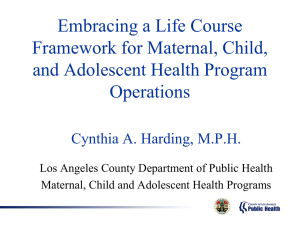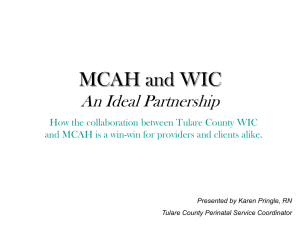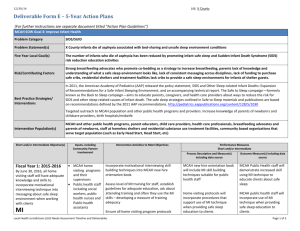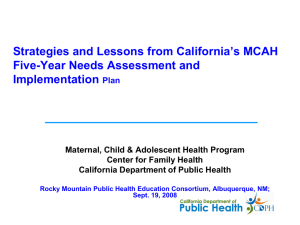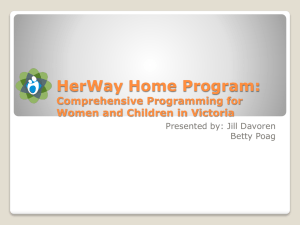MCAH Action Title V - Department of Family & Community Medicine
advertisement
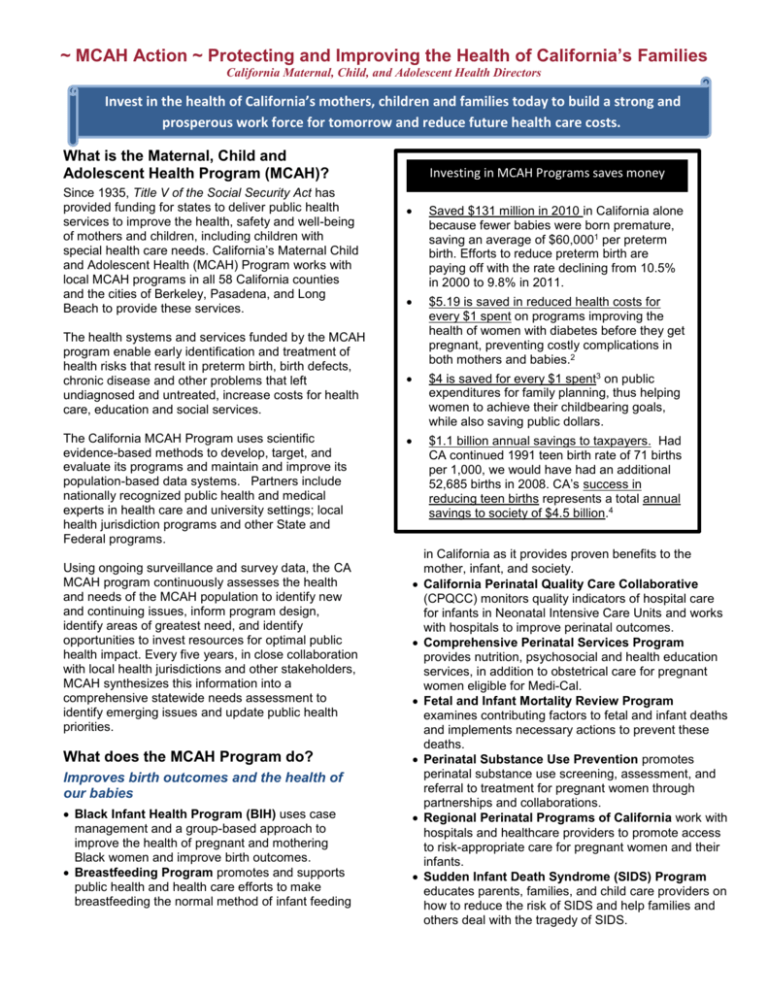
~ MCAH Action ~ Protecting and Improving the Health of California’s Families California Maternal, Child, and Adolescent Health Directors Invest in the health of California’s mothers, children and families today to build a strong and prosperous work force for tomorrow and reduce future health care costs. What is the Maternal, Child and Adolescent Health Program (MCAH)? Since 1935, Title V of the Social Security Act has provided funding for states to deliver public health services to improve the health, safety and well-being of mothers and children, including children with special health care needs. California’s Maternal Child and Adolescent Health (MCAH) Program works with local MCAH programs in all 58 California counties and the cities of Berkeley, Pasadena, and Long Beach to provide these services. The health systems and services funded by the MCAH program enable early identification and treatment of health risks that result in preterm birth, birth defects, chronic disease and other problems that left undiagnosed and untreated, increase costs for health care, education and social services. The California MCAH Program uses scientific evidence-based methods to develop, target, and evaluate its programs and maintain and improve its population-based data systems. Partners include nationally recognized public health and medical experts in health care and university settings; local health jurisdiction programs and other State and Federal programs. Using ongoing surveillance and survey data, the CA MCAH program continuously assesses the health and needs of the MCAH population to identify new and continuing issues, inform program design, identify areas of greatest need, and identify opportunities to invest resources for optimal public health impact. Every five years, in close collaboration with local health jurisdictions and other stakeholders, MCAH synthesizes this information into a comprehensive statewide needs assessment to identify emerging issues and update public health priorities. What does the MCAH Program do? Investing in MCAH Programs saves money Saved $131 million in 2010 in California alone because fewer babies were born premature, saving an average of $60,0001 per preterm birth. Efforts to reduce preterm birth are paying off with the rate declining from 10.5% in 2000 to 9.8% in 2011. $5.19 is saved in reduced health costs for every $1 spent on programs improving the health of women with diabetes before they get pregnant, preventing costly complications in both mothers and babies.2 $4 is saved for every $1 spent3 on public expenditures for family planning, thus helping women to achieve their childbearing goals, while also saving public dollars. $1.1 billion annual savings to taxpayers. Had CA continued 1991 teen birth rate of 71 births per 1,000, we would have had an additional 52,685 births in 2008. CA’s success in reducing teen births represents a total annual savings to society of $4.5 billion.4 Improves birth outcomes and the health of our babies Black Infant Health Program (BIH) uses case management and a group-based approach to improve the health of pregnant and mothering Black women and improve birth outcomes. Breastfeeding Program promotes and supports public health and health care efforts to make breastfeeding the normal method of infant feeding in California as it provides proven benefits to the mother, infant, and society. California Perinatal Quality Care Collaborative (CPQCC) monitors quality indicators of hospital care for infants in Neonatal Intensive Care Units and works with hospitals to improve perinatal outcomes. Comprehensive Perinatal Services Program provides nutrition, psychosocial and health education services, in addition to obstetrical care for pregnant women eligible for Medi-Cal. Fetal and Infant Mortality Review Program examines contributing factors to fetal and infant deaths and implements necessary actions to prevent these deaths. Perinatal Substance Use Prevention promotes perinatal substance use screening, assessment, and referral to treatment for pregnant women through partnerships and collaborations. Regional Perinatal Programs of California work with hospitals and healthcare providers to promote access to risk-appropriate care for pregnant women and their infants. Sudden Infant Death Syndrome (SIDS) Program educates parents, families, and child care providers on how to reduce the risk of SIDS and help families and others deal with the tragedy of SIDS. Reduces death and disease and improves the health of our moms California Diabetes and Pregnancy Program works with providers and community liaisons to promote improved outcomes for high-risk pregnant women with pre-existing diabetes and those who develop it. California Maternal Quality Care Collaborative (CMQCC) investigates causes of increased pregnancy-related morbidity and mortality that have Medi-Cal spending $106,923,000 on the 5.6% of births affected by gestational hypertension disorders5 and $105,956,000 on the 4.6% of births affected by hemorrhage6, and disseminates best obstetrical practices to save lives and reduce costs. Nutrition and Physical Activity Initiative integrates and coordinates healthy eating and physical activity promotion within MCAH and local public health and health care programs. Preconception Health and Health Care works with local programs to improve the health of women before they get pregnant and offers resources, tools and best practices for individuals, providers, and communities on everywomancalifornia.org Reduces deaths and chronic diseases and improves the health of our children California Early Childhood Comprehensive Systems is funded by a federal grant to create a comprehensive early childhood system for access to medical homes, mental health and socialemotional development, early care and education, parent education, and family support services. Childhood Injury Prevention Program provides assistance and training to local MCAH programs to integrate injury prevention into programs, policy and outreach activities Oral Health Program ensures oral health needs of pregnant women, mothers, and children, especially within low-income families, are met by expanding access to dental care and preventive services. Improves adolescent sexual and reproductive health and reduces teen pregnancy Adolescent Family Life Program (AFLP) provides case management, home visitation, and health education to pregnant and parenting teens and their families and raises community awareness of the problem of adolescent pregnancy in 35 local health jurisdictions. Personal Responsibility and Education Program (PREP) funds community organizations to educate high-risk and vulnerable adolescents on both abstinence and contraception by replicating evidence-based program models that have been proven to change behavior or reduce pregnancy among youth. Information and Education Program (I&E) funds educational programs that emphasize primary prevention to enhance knowledge, attitudes and skills of adolescents and young men and women of childbearing age to make responsible decisions relevant to sexual and reproductive behavior. Programs and services to women, infants and children have been cut and reduced as a result of budget cuts over the last 7 years Total MCAH Funding has Declined State Fiscal Years 2007-08 through 2012-13 (dollars in thousands) $140,000 $133,558 $130,000 $130,152 $120,000 $110,000 $100,000 SGF +Title V + Title XIX $90,000 $77,454 $74,767 $75,365 $70,900 $80,000 $70,000 Title V + Title XIX $60,000 $50,000 $40,000 2007-08 2008-09 2009-10 2010-11 2011-12 2012-13 State General Funds (SGF) for CA MCAH first reduced by 10% in State Fiscal Year (SFY) 2008-09 ($4.6M), were totally eliminated in SFY 2009-10 ($40M). Federal Title V funding for CA has dropped from $47.9M in 2005 to $41.1M 2012, while CA’s population grew from 35.3 to 37.3M. Due to sequestration, a 2013 funding drop to $39.1M has been proposed. $10 million in matching Title XIX funds were lost due to reduction in SGF for MCAH. Local MCAH, AFLP and BIH programs have been cut or reduced services since their budgets and expenditures were cut 30%-60% since the reduction of SGF and matching Federal Title XIX Funds from FY 2008 and 2009. $20.4M was eliminated FY 2009-2010 from the State SGF budget for the MCAH Domestic Violence Program. Local general funds for MCAH programs continue to be reduced or eliminated. Federal, State, and local funding cuts are impacting the ability of MCAH programs to serve California’s families while the demand for services continues rising. Institute of Medicine (IOM). Report Brief: Preterm Birth: Causes, Consequences, and Prevention. Washington, D.C., National Academies Press, 2006. http://www.iom.edu/reports/2006/preterm-birth-causesconsequences-and-prevention.aspx, accessed June 19, 2013. NOTE – 2005 costs were adjusted for inflation to 2012 dollars 2 Scheffler RM, Feuchtbaum LB, Phibbs CS. Prevention: the cost-effectiveness of the California Diabetes and Pregnancy Program. Am J Public Health 1992;82:168–75 3 Frost, Jennifer J., DrPH et al. The Impact of Publicly Funded Family Planning Clinic Services on Unintended Pregnancies and Government Cost Savings. Journal of Health Care for the Poor and Underserved 19 (2008): 778–796. http://www.guttmacher.org/pubs/09_HPU19.3Frost.pdf, accessed May 1, 2009 4 Constantine NA, Jerman P and Nevarez CR. No Time for Complacency: Teen Births in California. 2010 Spring Update. Berkeley, CA: Public Health Institute, 2010. 5 Pourat N, Martinez AE, Jones, JM, Gregory KD, Korst L, Kominski GF. Costs of Gestational Hypertensive Disorders in California: Hypertension, Preeclampsia, and Eclampsia. Los Angeles (CA): UCLA Center for Health Policy Research; 2013. 6 Pourat N, Martinez AE, McCullough, JC, Gregory KD, Korst L, Kominski GF. Costs of Maternal Hemorrhage in California. Los Angeles (CA): UCLA Center for Health Policy Research; 2013. Institute of Medicine (IOM). Report Brief: Preterm Birth: Causes, Consequences, and Prevention. Washington, D.C., National Academies Press, 2006. http://www.iom.edu/reports/2006/preterm-birth-causes-consequences-andprevention.aspx, accessed June 19, 2013. NOTE – 2005 costs were adjusted for inflation to 2012 dollars 2 Scheffler RM, Feuchtbaum LB, Phibbs CS. Prevention: the cost-effectiveness of the California Diabetes and Pregnancy Program. Am J Public Health 1992;82:168–75 3 Frost, Jennifer J., DrPH et al. The Impact of Publicly Funded Family Planning Clinic Services on Unintended Pregnancies and Government Cost Savings. Journal of Health Care for the Poor and Underserved 19 (2008): 778–796. http://www.guttmacher.org/pubs/09_HPU19.3Frost.pdf, accessed May 1, 2009 4 Constantine NA, Jerman P and Nevarez CR. No Time for Complacency: Teen Births in California. 2010 Spring Update. Berkeley, CA: Public Health Institute, 2010. 5 Pourat N, Martinez AE, Jones, JM, Gregory KD, Korst L, Kominski GF. Costs of Gestational Hypertensive Disorders in California: Hypertension, Preeclampsia, and Eclampsia. Los Angeles (CA): UCLA Center for Health Policy Research; 2013. 6 Pourat N, Martinez AE, McCullough, JC, Gregory KD, Korst L, Kominski GF. Costs of Maternal Hemorrhage in California. Los Angeles (CA): UCLA Center for Health Policy Research; 2013.
